
The hummingbird hawk-moth is a species of hawk moth found across temperate regions of Eurasia. The species is named for its similarity to hummingbirds, as they feed on the nectar of tube-shaped flowers using their long proboscis while hovering in the air; this resemblance is an example of convergent evolution.

Macroglossum affictitia, the dark-bordered hummingbird hawkmoth, is a moth of the family Sphingidae. It is known from Sri Lanka and southern India to Myanmar, Thailand and south-western Yunnan, China. It was described by Arthur Gardiner Butler in 1875.

Macroglossum belis, the common hummingbird hawkmoth, is a moth of the family Sphingidae. It was described by Carl Linnaeus in his 1758 10th edition of Systema Naturae. It is known from Sri Lanka, India, Nepal, Thailand, southern China, Taiwan, Japan, Vietnam and Indonesia (Java).
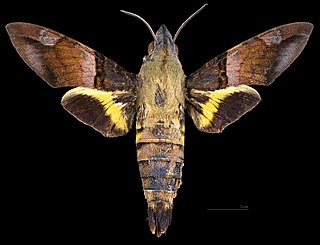
Macroglossum faro, the large hummingbird hawkmoth, is a moth of the family Sphingidae. It is known from southern India, Thailand, south-eastern China, southern Japan, Vietnam, Malaysia and Indonesia.

Macroglossum glaucoptera, the dark hummingbird hawkmoth, is a moth of the family Sphingidae. It was described by Arthur Gardiner Butler in 1875. It is known from Sri Lanka, Thailand, southern China, Vietnam, Malaysia (Peninsular), Indonesia and the Philippines (Mindanao). Single specimen recorded from Papua New Guinea.

Macroglossum divergens, the broad-bordered hummingbird hawkmoth, is a moth of the family Sphingidae. It was described by Jean Baptiste Boisduval in 1875. It is found from north-eastern Sikkim, India across southern China to Cheju Island, southern Japan, Taiwan and the Philippines and then south through Vietnam, Thailand, Malaysia and Indonesia to New Guinea and neighbouring islands. It may be in Sri Lanka.
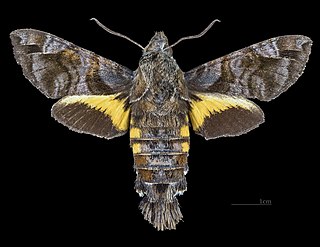
Macroglossum insipida, the hermit hummingbird hawkmoth, is a moth of the family Sphingidae. It was described by Arthur Gardiner Butler in 1875.

Macroglossum nycteris, the Himalayan hummingbird hawkmoth, is a moth of the family Sphingidae.
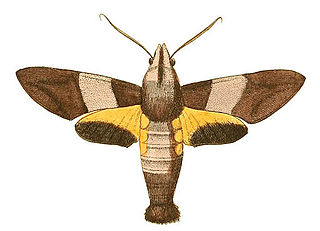
Macroglossum passalus, the black-based hummingbird hawkmoth, is a moth of the family Sphingidae described by Dru Drury in 1773. It is known from Sri Lanka, India, Thailand, south-eastern China, Taiwan, southern Japan, Indonesia and the Philippines.

Macroglossum pyrrhosticta, the maile pilau hornworm or burnt-spot hummingbird hawkmoth, is a hawk moth of the family Sphingidae. The species was first described by Arthur Gardiner Butler in 1875.

Macroglossum sitiene, the crisp-banded hummingbird hawkmoth, is a moth of the family Sphingidae described by Francis Walker in 1856.

Macroglossum vicinum, or Jordan's hummingbird hawkmoth, is a moth of the family Sphingidae. It is known from southern India, southern China and Thailand.
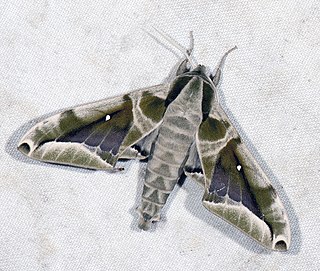
Parum is monotypic moth genus in the family Sphingidae erected by Walter Rothschild and Karl Jordan in 1903. Its single species, Parum colligata, was first described by Francis Walker in 1856.
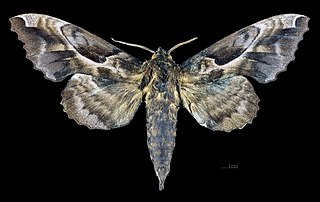
Phyllosphingia is a monotypic moth genus in the family Sphingidae erected by Charles Swinhoe in 1897. Its only species, Phyllosphingia dissimilis, the buff-leaf hawkmoth, was described by Otto Vasilievich Bremer in 1861.
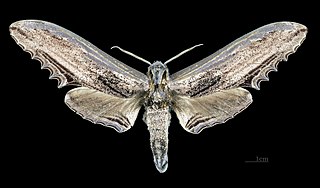
Langia zenzeroides, the apple hawkmoth, is a moth of the family Sphingidae. It was described by Frederic Moore in 1872.

Macroglossum variegatum, the variegated hummingbird hawkmoth, is a moth of the family Sphingidae. It is known from north-eastern India, southern China, Thailand, Vietnam, Malaysia and Indonesia.

Neogurelca himachala, the crisp-banded hawkmoth, is a moth of the family Sphingidae. It is known from Nepal, north-eastern India, south-western, central and eastern China, northern Thailand, Taiwan, North Korea, South Korea and Japan.
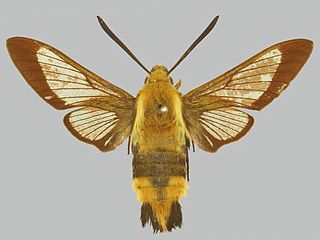
Hemaris affinis, the honeysuckle bee hawkmoth, is a moth of the family Sphingidae. It is known from Mongolia, the Russian Far East, northern, central and eastern China, Taiwan, North Korea, South Korea and Japan.

Meganoton analis, the grey double-bristled hawkmoth, is a moth of the family Sphingidae. It is known from India, Nepal, southern and eastern China, northern Thailand, northern Vietnam, Peninsular Malaysia, Indonesia, Taiwan, the southern part of the Russian Far East, South Korea and Japan.
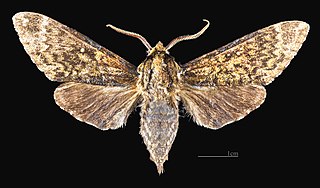
Dolbina exacta, the exact grizzled hawkmoth, is a species of moth of the family Sphingidae.




















